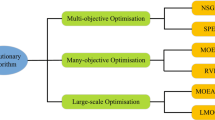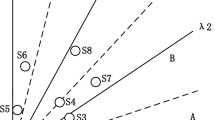Abstract
In this paper we proposed a many-objective evolutionary algorithm by combining the reference point-based selection in NSGA-III and the vector angle-based selection in VaEA. Performance of the proposed algorithm is verified by testing on the negative version of four DTLZ functions. The proposed algorithm is better than NSGA-III and is comparable to VaEA in terms of IGD. Besides, the proposed algorithm is more robust and can expand the front better.
Access this chapter
Tax calculation will be finalised at checkout
Purchases are for personal use only
Similar content being viewed by others
References
Deb, K., Pratap, A., Agarwal, S., Meyarivan, T.: A fast and eitist multiobjective genetic algorithm: NSGA-II. IEEE Trans. Evol. Comput. 6(2), 181–192 (2002). [NSGA-II]
Zitzler, E., Laumanns, M., Thiele, L.: SPEA2: Improving the strength Pareto evolutionary algorithm. Technical Report 103, Department of Electrical Engineering, Swiss Federal Institute of Technology (ETH), Zürich, Switzerland (2001). [SPEA2]
Ishibuchi, H., Tsukamoto, N., Nojima, Y.: Evolutionary many-objective optimization: a short review. In: Proceedings of the IEEE Conference on Evolutionary Computation, pp. 2419–2426 (2008)
Deb, K., Jain, H.: An evolutionary many-objective optimization algorithm using reference-point based non-dominated sorting approach, part I: solving problems with box constraints. IEEE Trans. Evol. Comput. 18(4), 577–601 (2014). [NSGA-III]
Zhang, Q., Li, H.: MOEA/D: a multiobjective evolutionary algorithm based on decomposition. IEEE Trans. Evol. Comput. 11(6), 712–731 (2007). [MOEA/D]
Li, K., Deb, K., Zhang, Q., Kwong, S.: An evolutionary many-objective optimization algorithm based on dominance and decomposition. IEEE Trans. Evol. Comput. 19(5), 694–716 (2015). [MOEA/DD]
Yuan, Y., Xu, H., Wang, B., Yao, X.: A new dominance relation-based evolutionary algorithm for many-objective optimization. IEEE Trans. Evol. Comput. 20(1), 16–37 (2016). [Theta-DEA]
Xiang, Y., Zhou, Y., Li, M.: Chen. Z.: A vector angle-based evolutionary algorithm for unconstrained many-objective optimization. IEEE Trans. Evol. Comput. 21(1), 131–152 (2017). [VaEA]
Asafuddoula, M., Ray, T., Sarker, R.: A decomposition-based evolutionary algorithm for many objective optimization. IEEE Trans. Evol. Comput. 19(3), 445–460 (2015). [I-DBEA]
He, Z., Yen, G.: Many-objective evolutionary algorithms based on coordinated selection strategy. IEEE Trans. Evol. Comput. 21(2), 220–233 (2017). [MaOEA-CSS]
Yuan, Y., Xu, H., Wang, B., Zhang, B., Yao, X.: Balancing convergence and diversity in decomposition-based many-objective optimizers. IEEE Trans. Evol. Comput. 20(2), 180–198 (2016). [MOEA/D-DU]
Das, I., Dennis, J.: Normal-boundary intersection: A new method for generating the Pareto surface in nonlinear multicriteria optimization problems. SIAM J. Optim. 8(3), 631–647 (1998)
Ishibuchi, H., Setoguchi, Y., Masuda, H., Nojima, Y.: Performance of decomposition-based many-objective algorithms strongly depends on Pareto front shapes. IEEE Trans. Evol. Comput. 21(2), 169–190 (2017)
Deb, K., Thiele, L., Laumanns, M., Zitzler, E.: Scalable test problems for evolutionary multiobjective optimization. In: International Conference on Evolutionary Multi-Criterion Optimization, pp. 105–145. Springer (2005). [DTLZ]
Acknowledgement
This research was supported by the Ministry of Science and Technology of Taiwan (R.O.C.) under Grant No. 105-2221-E-003-021.
Author information
Authors and Affiliations
Corresponding author
Editor information
Editors and Affiliations
Rights and permissions
Copyright information
© 2018 Springer Nature Singapore Pte Ltd.
About this paper
Cite this paper
Lee, CY., Yeh, JF., Chiang, TC. (2018). A Many-Objective Evolutionary Algorithm with Reference Point-Based and Vector Angle-Based Selection. In: Lin, JW., Pan, JS., Chu, SC., Chen, CM. (eds) Genetic and Evolutionary Computing. ICGEC 2017. Advances in Intelligent Systems and Computing, vol 579. Springer, Singapore. https://doi.org/10.1007/978-981-10-6487-6_1
Download citation
DOI: https://doi.org/10.1007/978-981-10-6487-6_1
Published:
Publisher Name: Springer, Singapore
Print ISBN: 978-981-10-6486-9
Online ISBN: 978-981-10-6487-6
eBook Packages: EngineeringEngineering (R0)




